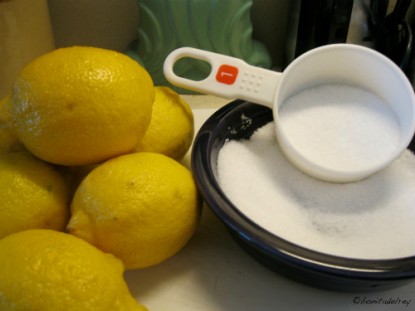
Skip the lemonade and go directly to preserved lemons. This condiment adds a unique, soft, and subtle flavor to a variety of dishes. Popular in Mediterranean regions from Tunisia to France and Morocco to Spain, these bits of sunshine are also prized in South Indian cuisine. The all-natural fruit lends a brightness to foods such as rice, baked fish and chicken, soups and stews, and countless other dishes. It is an essential ingredient of chicken tagine. All you’ll need for preserved lemons is lemons, salt, and time!
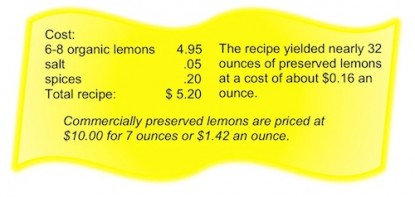
How to make Preserved Lemons: Printable
- 6-8 Lemons
- Salt
Some recipes indicate a preference for the thinner-skinned, sweeter Meyer lemons, others indicate that Meyer lemons become slightly mushy when preserved. Eureka lemons are perfectly acceptable. Choose smaller lemons if possible, they will be easier to close-pack in the preserving jar. Further, since you are preserving the entire lemon, organic lemons are highly recommended.
Additive-free kosher salt, or sea salt, are best for this recipe. Ordinary table salt will add a harsh, chemical taste.
To begin, scrub lemons with a vegetable brush and dry them well. Cut off the little rounded bit, or nib, at the stem end.
Hold lemons over a plate or bowl to catch any juice. On the end opposite the nib, make a large cut by slicing lengthwise downward. Make a second downward slice, so you’ve incised the lemon with an X shape. Avoid making the cuts so deep that the lemon separates into quarters.
Pack salt into the lemon where you made the cuts. Be generous; use about 1 tablespoon salt per lemon.
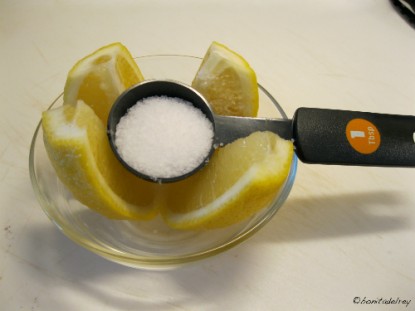
Put a couple of tablespoons of salt in the bottom of a sterilized quart glass jar with a tight-fitting lid. Add the salt-filled lemons, packing fruit in layers, and sprinkling a thin layer of salt between each layer. Push the lemons down firmly to pack them tightly and to help express some of their juice. I used a pestle from a mortar and pestle set to help shmoosh the lemons into the jar.
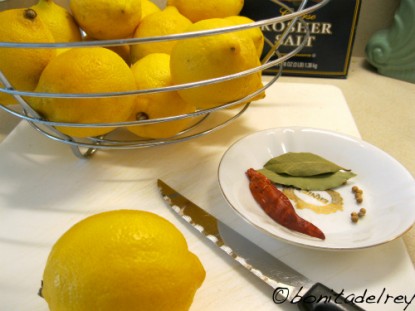
If you desire, add a Safi spice mixture—a few coriander seeds, a bay leaf, a dried chili, and a cinnamon stick, or any combination of these. Finish with a final layer of salt. Cover the jar tightly and let stand overnight.
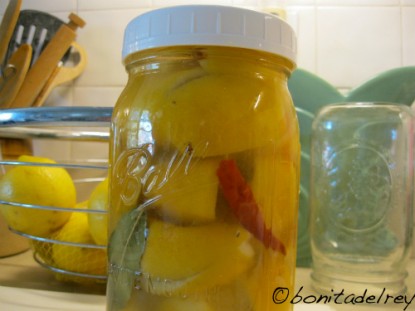
The next day, press lemons down again. Encourage them to release more juice as they begin to soften. Repeat for 2 to 3 days. My lemons were not overly juicy, so I needed to add more freshly-squeezed lemon juice. It is important to make certain the lemons are completely covered with salted lemon juice. After about a month the preserved lemons will be soft and ready to use. While preserved lemons are kept in pantries in North Africa, most U.S. chefs recommend keeping them under refrigeration where they will last for months.
(As it happens, this method is suitable for preserving limes as well as lemons. Pickled limes were fashionable New England treats in the middle of the 19th century. Remember all those pickled limes Amy March loved?)
Preserved lemons are both intensely salty and acidic, a little bit goes a long way. Their unique pickled taste and special silken texture cannot be duplicated with fresh lemon or lime juice. During the preserving process, the lemons release their juice into the brine, creating a lemon infusion that is wonderful in soups and sauces. The pickling juice is particularly welcome in Bloody Marys and salad dressings. If desired, cook with both pulp and rind.
Do not fish the lemons out of the brine using your fingers; avoid metal utensils as well. Use a plastic picnic fork or wooden utensil to remove the lemons instead.
Occasionally, there may be a lacy, white substance clinging to preserved lemons in the jar. It is perfectly harmless, but for aesthetic reasons it should be rinsed off just before the lemons are used. In any case, lemons should be rinsed to reduce their saltiness.
If you wish, pull lemons apart. Scrape out the pulp and pith using the dull edge of a knife, this removes any bitterness. Slice lemon peel into thin strips or cut into small dice and add to steamed fish, roasted chicken, and grain dishes. Diced peel can be mixed into your favorite sauces, or gremolata. Toss with salads. Garnish grilled meat or place a slice or two into a tuna fish sandwich. Surprise family and guests by using preserved lemon as a garnish for vanilla ice cream or a fruit granita.
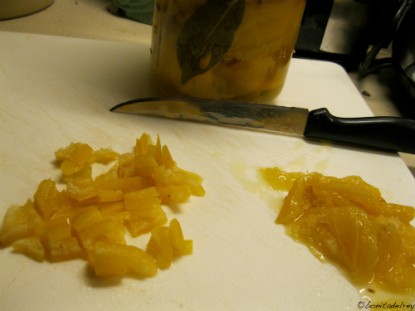
To get you started, here are three recipes that rely on preserved lemons for their spark and personality:
- Spinach Sauté With Red Bell Pepper and Preserved Lemons
- Pine Nut and Preserved Lemon Couscous
- Chicken with Preserved Lemon and Olives
Do you have a recipe post or kitchen-related story to share on the Farm Bell blog?
See Farm Bell Blog Submissions for information, the latest blog contributor giveaway, and to submit a post.
Want to subscribe to the Farm Bell blog? Go here.



Suzanne McMinn says:
bonita, this would work with oranges as well, right? I love this idea!
On January 30, 2012 at 6:27 am
Robin from Rurification says:
We discovered these last year and have made a bunch since then. Lovely in chicken dishes, but most of them get snacked on. Mmmm.
On January 30, 2012 at 7:43 am
TeaCup says:
I made a jar of salted (nothing else just salt) lemons a while back and didn’t use them, in a LONG time. When I got ready to use them 1)I couldnt’ get the metal lid off the jar and 2)the entire mass of salt had become a solid brick.
So warnings here: Do NOT use jars with metal lids and do NOT add a lot of extra salt, add the thin layer specified above.
I finally tossed the jar btw!
It is so nice to have a set of instructions with pictures and specific instructions. Thank you!
Judi
On January 30, 2012 at 8:35 am
bonita says:
Suzanne: Not sure same process would work with oranges. I’d be concerned that orange peel is much thicker than lemon/lime peel and that oranges are not as acidic as either lemons or limes. Nearly all preserved orange recipes I found included a bit of cooking, sugar, and/or BWB in process.
Further study finds:
Lemons and limes tend to be 60 times more acidic than oranges and grapefruit. (0.30 mol/L vs (0.005 mol/L)
On January 30, 2012 at 10:12 am
Suzanne McMinn says:
I see what you mean. Thanks, bonita!
On January 30, 2012 at 10:42 am
Lana says:
Bonita – what a coincidence! Three weeks ago I found a recipe for preserved lemons and put up a couple of pints. The recipe I used said to shake the jars twice a day to distribute the salt. One more week, and I can taste them! Can hardly wait! I love, love lemons.
On January 30, 2012 at 11:04 am
Lana says:
P.S. According to Jamie Oliver’s recipe (Salted Preserved Lemons), oranges can also be preserved using this method. Don’t know how to post the web site address, but I’m sure you could google it.
On January 30, 2012 at 11:18 am
bonita says:
Lana—I know, the recipe is easy, waiting is the difficult part.
Oliver’s recipe is at http://www.foodnetwork.com/recipes/jamie-oliver/salted-preserved-lemons-recipe/index.html
I’d still be cautious, this is the only reference I’ve found that indicates oranges could be preserved this way. Other sspecifically recommended additional treatment.
Judi—I hope you’ll try them again…they’re worth it!
Robin—Have you tried them on tuna fish sandwiches…Really, you won’t believe the improvement!
On January 30, 2012 at 2:34 pm